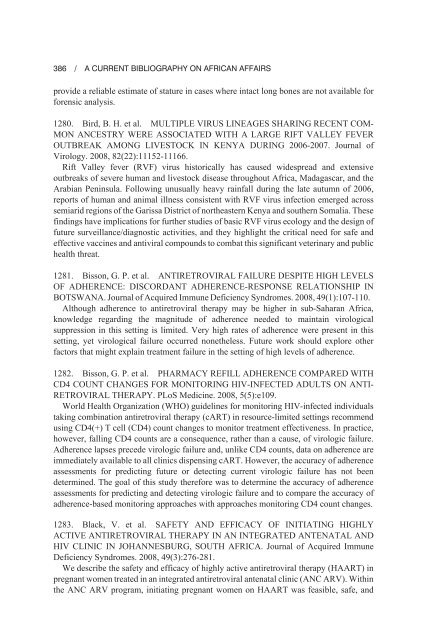A Current Bibliography on African Affairs - Baywood Publishing
A Current Bibliography on African Affairs - Baywood Publishing
A Current Bibliography on African Affairs - Baywood Publishing
You also want an ePaper? Increase the reach of your titles
YUMPU automatically turns print PDFs into web optimized ePapers that Google loves.
386 / A CURRENT BIBLIOGRAPHY ON AFRICAN AFFAIRS<br />
provide a reliable estimate of stature in cases where intact l<strong>on</strong>g b<strong>on</strong>es are not available for<br />
forensic analysis.<br />
1280. Bird, B. H. et al. MULTIPLE VIRUS LINEAGES SHARING RECENT COM-<br />
MON ANCESTRY WERE ASSOCIATED WITH A LARGE RIFT VALLEY FEVER<br />
OUTBREAK AMONG LIVESTOCK IN KENYA DURING 2006-2007. Journal of<br />
Virology. 2008, 82(22):11152-11166.<br />
Rift Valley fever (RVF) virus historically has caused widespread and extensive<br />
outbreaks of severe human and livestock disease throughout Africa, Madagascar, and the<br />
Arabian Peninsula. Following unusually heavy rainfall during the late autumn of 2006,<br />
reports of human and animal illness c<strong>on</strong>sistent with RVF virus infecti<strong>on</strong> emerged across<br />
semiarid regi<strong>on</strong>s of the Garissa District of northeastern Kenya and southern Somalia. These<br />
findings have implicati<strong>on</strong>s for further studies of basic RVF virus ecology and the design of<br />
future surveillance/diagnostic activities, and they highlight the critical need for safe and<br />
effective vaccines and antiviral compounds to combat this significant veterinary and public<br />
health threat.<br />
1281. Biss<strong>on</strong>, G. P. et al. ANTIRETROVIRAL FAILURE DESPITE HIGH LEVELS<br />
OF ADHERENCE: DISCORDANT ADHERENCE-RESPONSE RELATIONSHIP IN<br />
BOTSWANA. Journal of Acquired Immune Deficiency Syndromes. 2008, 49(1):107-110.<br />
Although adherence to antiretroviral therapy may be higher in sub-Saharan Africa,<br />
knowledge regarding the magnitude of adherence needed to maintain virological<br />
suppressi<strong>on</strong> in this setting is limited. Very high rates of adherence were present in this<br />
setting, yet virological failure occurred n<strong>on</strong>etheless. Future work should explore other<br />
factors that might explain treatment failure in the setting of high levels of adherence.<br />
1282. Biss<strong>on</strong>, G. P. et al. PHARMACY REFILL ADHERENCE COMPARED WITH<br />
CD4 COUNT CHANGES FOR MONITORING HIV-INFECTED ADULTS ON ANTI-<br />
RETROVIRAL THERAPY. PLoS Medicine. 2008, 5(5):e109.<br />
World Health Organizati<strong>on</strong> (WHO) guidelines for m<strong>on</strong>itoring HIV-infected individuals<br />
taking combinati<strong>on</strong> antiretroviral therapy (cART) in resource-limited settings recommend<br />
using CD4(+) T cell (CD4) count changes to m<strong>on</strong>itor treatment effectiveness. In practice,<br />
however, falling CD4 counts are a c<strong>on</strong>sequence, rather than a cause, of virologic failure.<br />
Adherence lapses precede virologic failure and, unlike CD4 counts, data <strong>on</strong> adherence are<br />
immediately available to all clinics dispensing cART. However, the accuracy of adherence<br />
assessments for predicting future or detecting current virologic failure has not been<br />
determined. The goal of this study therefore was to determine the accuracy of adherence<br />
assessments for predicting and detecting virologic failure and to compare the accuracy of<br />
adherence-based m<strong>on</strong>itoring approaches with approaches m<strong>on</strong>itoring CD4 count changes.<br />
1283. Black, V. et al. SAFETY AND EFFICACY OF INITIATING HIGHLY<br />
ACTIVE ANTIRETROVIRAL THERAPY IN AN INTEGRATED ANTENATAL AND<br />
HIV CLINIC IN JOHANNESBURG, SOUTH AFRICA. Journal of Acquired Immune<br />
Deficiency Syndromes. 2008, 49(3):276-281.<br />
We describe the safety and efficacy of highly active antiretroviral therapy (HAART) in<br />
pregnant women treated in an integrated antiretroviral antenatal clinic (ANC ARV). Within<br />
the ANC ARV program, initiating pregnant women <strong>on</strong> HAART was feasible, safe, and




